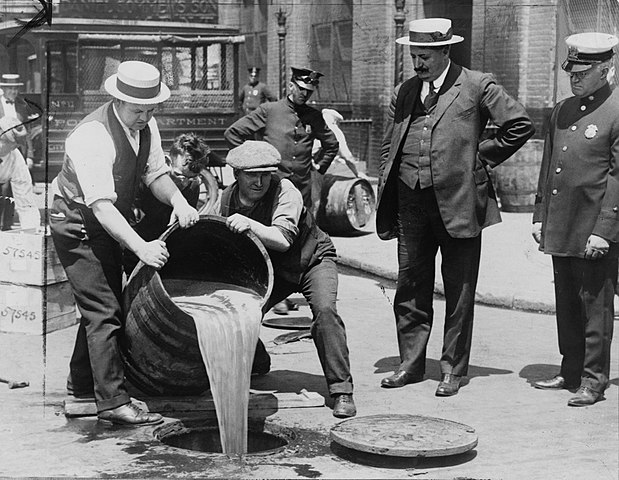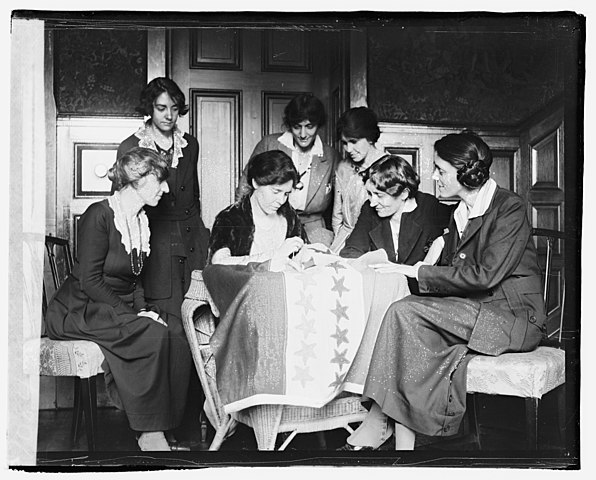Major Events
Following the end of the First World War and a deadly world-wide influenza epidemic at the end of the previous decade, people were ready to enjoy themselves again in the 1920s. In 1920s Britain, people held victory balls, which were fancy dress balls held on November 11, Remembrance Day, commemorating the end of the war and raising money for charities. Some people thought that the party atmosphere was unseemly for a solemn day of remembrance, but others said that it was a fitting celebration of life. The victory balls became less popular in the late 1920s.
Most people think of the 1920s as the Jazz Age or the decade of Prohibition (1920 to 1933) in the United States. In spite of the ban on alcohol, people found various ways around the law, such as making bootleg liquor or visiting "speakeasies," where alcohol was illicitly sold, often the activity of many famous gangsters like Al Capone, but private proprietors could also operate speakeasies. To avoid being caught by the authorities, speakeasies would only admit people who knew the secret password or had a membership card (The Speakeasies of the 1920s). Different speakeasies used other tricks to avoid being caught in case of a raid, like using secret cabinets to store their illegal goods or serving alcohol in teacups so it would look more innocent at a casual glance (Speakeasies of the Prohibition Era). In spite of the attempts at secrecy, the existence of the speakeasies was generally well-known. It was common for proprietors to bribe police officers to avoid raids (The Speakeasies of the 1920s).

Used as a speakeasy for guests in the early years of the hotel
From Wikimedia Commons (CC BY-SA 4.0)
There were other ways for people to get around Prohibition laws. For example, while buying or making alcohol was illegal, it was considered perfectly legal to drink existing supplies of alcohol in private at home. People who had a store of alcohol from before Prohibition were free to drink it. Wineries that could no longer sell wine sold bricks of dried grapes with instructions for what to do with them to make grape juice and other instructions for what not to do with them in order to make wine (as shown in How Americans Found a Clever Loophole in the Prohibition Act). Once private individuals got hold of them, they could follow the set of instructions that they wanted to follow, and it was difficult to prove what they had done. Alcohol was also allowed a certain distance from shore, so wealthy people who owned boats would throw parties on their boats with alcohol.

disposing of alcohol in a sewer after a raid
From Wikimedia Commons (Considered public domain in the US)
The 19th Amendment to the Constitution, ratified in 1920, gave American women the right to vote. During the 1920s, American women experienced a new sense of independence and became more interested in having careers of their own.

From Wikipedia (Considered public domain in the US)
The Ku Klux Klan also experienced a resurgence of popularity during the 1920s, partly as a reaction to sudden changes in society, anti-immigrant attitudes, fears of communists because of events in Bolshevik Russia, and the feeling of wanting to return to “normalcy.” (What is considered “normal” is relative, and for some people, the Ku Klux Klan inspired feelings of nostalgia, as shown in D.W. Griffith’s 1915 film “Birth of a Nation”, especially the second half. Many people found it inspiring. Personally, I thought most of the movie was dumb and boring. Parts were shocking, but the rest was dull, and I didn't like the characters.) To put this into context, anyone born during the American Civil War (1861 to 1865) would have been in their 60s during the 1920s. Even though they wouldn’t have grown up during a time when slavery was legal, their parents would have. Anyone who was an adult during the 1920s would have been old enough to know people (perhaps parents or grandparents) who were alive when slavery was legal. Some of their parents or grandparents may even have been slave holders or veterans of the Civil War. In general, the older generations may have painted a rosy picture of what life was like before the Civil War began, and the stories that children hear from their elders can make a lifelong impression. The point is that when you decide to “return to normalcy,” some people might want to go back farther than others.
From Wikimedia Commons (Considered public domain in the US)

From Wikipedia
(Considered public domain in the United States)
In 1922, Howard Carter discovered the tomb of Tutankhamun in the Valley of the Kings, leading to a craze for Egyptian art and culture. People would often buy clothes, jewelry, and other objects with Egyptian motifs on them, and there were a number of novelty songs about Egypt.
Also in 1922, the Union of Soviet Socialist Republics (aka The USSR or Soviet Union) was created, and Benito Mussolini became Prime Minister of Italy. Mussolini created the world's first fascist government. These developments helped to set the stage for events to come during the Second World War and the following Cold War.
In 1927, Charles Lindbergh became famous for his solo transatlantic flight from New York to Paris in his airplane, the Spirit of St. Louis, increasing national interest in airplanes and air travel. Charles Lindbergh is the same Lindbergh whose young son was kidnapped in the famous Lindbergh kidnapping case in 1932 and later came under fire for his opposition to the US entering WWII.
Alexander Fleming discovered penicillin in 1928, saving the lives of many people suffering from infectious diseases.
“Prosperity” and “normalcy” were the new battle cries of American society after World War I, and the country practiced an aggressive form of capitalism in pursuit of these goals. The general public venerated people who were rich and successful, and mass production was in vogue. The United States became more influential internationally through financial interests. The decade ended with the crash of the stock market and the beginning of the Great Depression.
Daily Life During The 1920s
The 1920s was when radio was popularized as a form of home entertainment. Society was committed to enjoying itself after the hardships of the First World War. They enjoyed various entertainment fads and crazes, including crazes for Mahjong, crossword puzzles (the first crossword puzzle book was published in 1924 and came with a pencil included, although crossword puzzles had existed previously, published in newspapers and magazines), quizzes, and Bridge.
During the 1920s, young women started wearing simpler, less restricting clothes than previous generations of women did. Many of them cut their hair shorter in “bobs” and wore much shorter skirts. They became the image of the "flapper", daring young women who pushed the limits of society’s expectations. (“Bright Young Things” were young people, both men and women, in Britain, especially in the upper classes who similarly dressed daringly and acted outrageously, pushing the limits of society in the name of fun and a new sense of independence.) For more information about women's dress and habits during the 1920s, see the section about women below.
For men, suits and fedora hats were common, but more casual clothes, like sweaters, knickerbockers, and sportswear were also becoming popular. Loose-fitting pants with wide legs called Oxford Bags were also in fashion. Men's evening clothes no longer had long tails. Instead, men were wearing tuxedos. Young men in college liked to wear raccoon coats, which were long fur coats of the kind that more modern people might expect a woman to wear (1920s Men's Fashion).
Women
Describes the lives of women and women's social issues.
Children
Describes the lives of children, their education, and children's books.
Food
Describes things people ate during the 1920s and new foods and recipes that developed during this time.
Entertainment
Describes popular forms of entertainment, including music, movies, and books for adults.
Resources
Books
Only Yesterday by Frederick Lewis Allen, 1931.
A look back on the events of the previous decade and popular culture during the 1920s, written by someone who had just witnessed it.
Cheaper By the Dozen by Frank B. Gilbreth, Jr. and Ernestine Gilbreth Carey, 1948.
These are the real reminiscences of children from the Gilbreth family about their unusual childhoods during the 1910s and 1920s.
Our Hearts Were Young and Gay by Cornelia Otis Skinner and Emily Kimbrough, 1942.
The humorous reminiscences of a pair of best friends about their first trip to Europe as young women in the 1920s. A fun look at the attitudes of young women and their sense of independence yet relative innocence when compared with more modern young people. There is a humorous scene in which the girls have a kind of revelation about “the facts of life” (which their parents never really explained to them) while looking at art in a museum. Although they never say anything explicit, it’s worthy of a chuckle from more knowing people. There’s also a scene in which Cornelia’s mother (her parents are never far behind the girls in their travels, which both explains a lot about how older adults viewed youthful independence and frequently proves helpful because the girls have little idea about what they’re doing and often need help) tries to explain to them the truth about a pair of homosexual young men, while at the same time not actually explaining anything at all, yet giving the girls the impression that they’ve learned something important, although they really aren’t sure what. It gives a good idea of what young women of the time knew and didn’t know and how the knowing but not knowing frequently happened at the same time. Actually, that experience is pretty timeless. This hilarious book was later made into a movie, although it’s difficult to find the movie these days.
General Documentaries
America in Color: The 1920s. From the Smithsonian Channel.
A history of the events of the decade. It is part of a series of documentaries of colorized footage of different decades. You can see this documentary online by subscribing to the Smithsonian Channel. It is also available for purchase through iTunes, fairly inexpensively. You can also see clips from this documentary on the Smithsonian Channel site.
1920s Style: Prohibition-Era Fashion Highlights
A video panel discussion about clothing in the 1920s presented by the US National Archives. It ends with a dance routine.
Getting Dressed in the 1920s - Eveningwear
A video demonstration of the evening clothes that a woman would wear in the 1920s and how she would get dressed and do her hair.
General Websites
A general overview of major events and popular culture of the 1920s.
An article about what flappers wore in the 1920s.
What Did Women Wear in the 1920s? 20s Clothing Trends
An article about what women wore in the 1920s with some information about men's clothing as well. The article talks about general trends but also has examples of outfits worn for different types of occasions, like work, travel, college, sports, and evenings out.